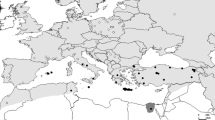Abstract
The Japanese regional population of the Oriental white stork (Ciconia boyciana) became extinct in 1986. Mitochondrial DNA (mtDNA) D-loop region from 20 mounted specimens preserved at public facilities in Toyooka City, Hyogo Prefecture, Japan and its vicinity (n = 17), the area inhabited by the last of the Japanese population, and samples originating from China (n = 3) which were kept at a zoo was analyzed. After extracting DNA from small pieces of skin from mounted specimens, a 1210-bp region of the mtDNA D-loop region was analyzed. The haplotypes among 11 specimens of storks captured or found dead at Toyooka City just before the population became extinct were completely identical. Four haplotypes observed among the mounted specimens preserved in the vicinity of Toyooka City were differentiated from those of captive storks originating from China and Russia in a previous study. Therefore, the last Japanese population might have been a genetically unique group. However, phylogenetic analysis using the maximum likelihood method showed that haplotypes found in the Japanese regional population were closely related to the Chinese and Russian lineages (sequence difference = 2.1%). One mounted specimen collected in 1935 at Izushi village, in the vicinity of Toyooka City, showed the same haplotype as the captive storks from China, suggesting that genetic flow may have historically occurred between the populations of Japan and the continent. Recently, reintroduction for the Oriental white stork has been planned in Toyooka City. The planning for the recovery of extinct populations should not only involve translocation of species to the range from which it disappeared, but also reconstruction of regional populations while considering the genetic lineage between the extinct and introduced populations.
Similar content being viewed by others
References
Felsenstein J (1981) Evolutionary trees from DNA sequences: a maximum likelihood approach. J. Mol.Evol.,17,368–376.
Felsenstein J (1985) Confidence limits on phylogenies: an ap-proach using the bootstrap. Evolution, 39,783–791.
Felsenstein J (1993) PHYLIP (Phylogeny Inference Package ) version 3.5c. Department of Genetics, University of Wash-ington, Seattle.
Hancock JA, Kushulan JA, Kahl MP (1992) Storks, Ibises and Spoonbills of the World. Academic Press, London.
IUCN/SSC Reintroduction Specialist Group (1995) IUCN/SSC Guideline for Reintroductions, IUCN, Nairobi, Kenya. (http://iucn.org/themes/ssc/pubs/policy/reinte.htm).
King WB (1981) Endangered species of the world. In: The ICBP Bird Red Databook. Smithsonian Institution Press and Inter-national Council for Bird Preservation, Washington, DC.
Marshall HD, Baker AJ (1997) Structural conservation and variation in the mitochondrial control region of Fringilline finches (Fringilla spp.) and the greenfinch (Carduelis chloris ). Mol. Biol. Evol., 14, 173–184.
Masuda R, Murata K, Aiurzaniin A, Yoshida M (1998a) Phylogenetic status of brown bears Ursus arctos of Asia: a preliminary result inferred from mitochondrial DNA control region sequences. Hereditas, 128, 277–280.
Masuda R, Noro M, Kurose N et al. (1998b) Genetic charac-teristics of endangered Japanese golden eagles (Aquila chrysaetos japonica ) based on mitochondrial DNA D-loop sequences and karyotypes. Zoo Biol., 17, 111–121.
Murata K (1997) Reintroduction plan for the Oriental white stork (Ciconia boyciana ) in Japan and its veterinarian's role. Jpn. J. Zoo Wildlife Med., 2, 117–122.
Murata K, Hasegawa T, Matsushima K (1993) The cause of death of Eastern white storks (Ciconia ciconia boyciana )in captivity. J. Jpn Assoc. of Zool. Gardens Aquariums, 34, 23–27 (in Japanese with English summary).
Ogawa H (2001) International studbook for the Oriental white stork Ciconia boyciana. Tama Zoological Society, Tokyo.
Ozawa S (2000) The extinction day of Medaka (Japanese title: Medaka ga kieru hi ), Iwanami Publishing Co., Tokyo (in Japanese).
Sakamoto M (1966) Kohnotori: Japanese Stork, Ciconia ciconia boyciana (Swinhoe ). Kobe Newspaper Press, Kobe (in Jap-anese with English summary).
Sambrook J, Fritsch EF, Maniatis T (1998) Molecular Cloning: A Laboratory Manual, 2nd edn. Cold Spring Harbor Labo-ratory Press, New York.
Suzuki H, Sato Y, Ohba N (2002) Gene diversity and geo-graphic differentiation in mitochondrial DNA of the Genji firefly, Luciola cruiata (Coleoptera: Lampyridae). Mol. Phylogen. Evol., 22,193–205.
Snyder NFR, Snyder H (2000) The California Condor: A Saga of Natural History and Conservation. Princeton University Press, New Jersey.
Tsuda TT, Tsuda M, Naruse T et al. (2001) Phylogenetic analysis of penguin (Spheniscidae ) species based on sequence variation in MHC class II genes. Immunogenetics, 53,712–716.
Yamamoto Y, Murata K, Matsuda H et al. (2000) Determi-nation of the complete nucleotide sequence and haplotypes in the D-loop region of the mitochondrial genome in the Oriental white stork, Ciconia boyciana. Genes Genetic Sys., 75,25–32.
Author information
Authors and Affiliations
Rights and permissions
About this article
Cite this article
Murata, K., Satou, M., Matsushima, K. et al. Retrospective Estimation of Genetic Diversity of an Extinct Oriental White Stork (Ciconia boyciana) Population in Japan Using Mounted Specimens and Implications for Reintroduction Programs. Conservation Genetics 5, 553–560 (2004). https://doi.org/10.1023/B:COGE.0000041022.71104.1f
Issue Date:
DOI: https://doi.org/10.1023/B:COGE.0000041022.71104.1f




